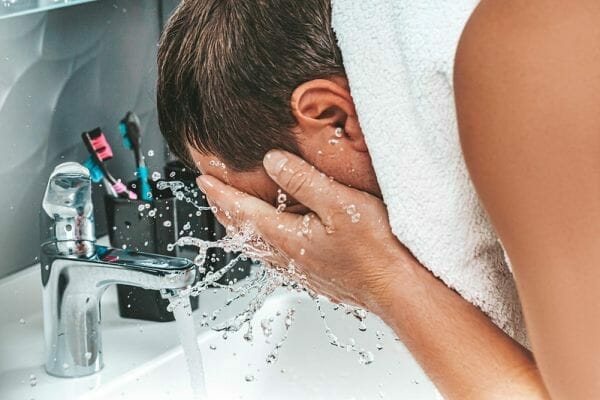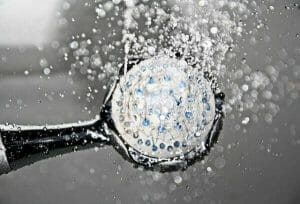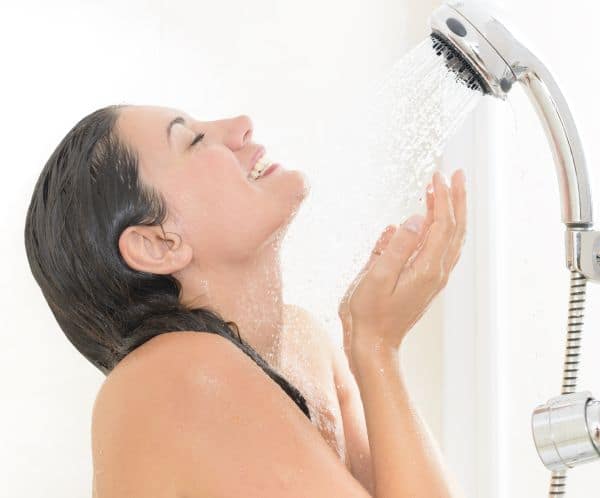Have you ever been in a shower when you were suddenly hit with hot, scalding water because someone ran a tap or flushed a toilet in the house? Was it not just the worst feeling? We know what it’s like!
If you have ever been in this uncomfortable situation, an anti- () can solve this problem for you! Anti- valves maintain the temperature of in a , , or at a set level at all times and prevent fluctuations.
Over the long term, an anti- can also save you money by reducing the flow of . It will also save you time that you might spend adjusting the .
In this article, we discuss what anti-scald valves are, how they can be useful, and how to adjust them.
Contents
Why Are Anti-scald Valves or Thermostatic Mixing Valves Useful?
Temperature fluctuations can be caused by changes in pressure in either the cold or hot line. For example, when someone flushes a toilet, cold water flows to the toilet and reduces the pressure in that line. Therefore, less cold water is available in the pipes.
Anyone bathing at that moment may feel a sudden increase in water temperature. This situation can be further worsened if the plumbing is either narrow or clogged, or there are several showerheads installed.
This kind of inadvertent temperature increase can lead to scalding. Even worse, it might cause the person who is taking a bath to get startled and lose balance, leading to other injuries such as fall injury. This puts elderly people and children at risk since they may be more susceptible to shock.
An anti-scald valve or a thermostatic mixing valve is the perfect solution for this kind of problem. The video below explains more about a thermostatic mixing valve and how it works.
Most home water heaters default to 140°F unless any changes have been made to them. At this temperature, it takes about 5 seconds for a severe burn to happen.
Instead, if we start using water at the standard recommended temperature (120°F), we may be encouraging bacterial growth. Bacteria can thrive at temperatures below 140º F, especially in moist places such as water heaters.

The elderly and children who tend to have a weaker immune system are susceptible to infection by the bacteria Legionella, which thrives at lowered temperatures. These bacteria are the root cause of Legionnaire disease, which is a severe form of Pneumonia. (source)
Legionnaire disease is known to spread primarily through water droplets. Factors such as water temperature and the mineral content of the water impact its growth.
Therefore, it is important to keep the water in the heater at a higher temperature (140°F+), while using a lower temperature at the point of bathing or washing (110° – 120°). This is where anti-scald valves come into the picture.
Anti-scald valves protect against both these dangers by maintaining water temperature at a safe level, despite fluctuations in the supply line. They are equipped with a mechanism that balances the cold and hot water inputs, keeping the temperature within a safe range.
Anti-scald valves or thermostatic mixing valves also increase the availability of hot water. They draw hot water more slowly from the pipes.
These valves ensure automatic water supply is cut off in case of a failure on either the cold or hot water supply side. This minimizes the possibility of an accident due to a sudden disruption in the pipeline supply.
You may also like Best Shower Gurney Beds for Elderly
How Do Anti-Scald Valves Work?
Pressure Balanced Valves
A anti scald pressure balanced valve is an inexpensive, simple design for an anti-scald valve. Essentially, a piston or a diaphragm is put inside the shower faucet, and it regulates water flow based on pressure changes.
If the warm water pressure drops, the piston limits the amount of cold-water flow, and vice versa. If the water heater temperature is changed, this kind of anti-scald valve must have its heating settings changed along with it.
Thermostatic Mixing Valves
Thermostatic mixing valves have the distinct advantage of not having to be calibrated after being installed once. They operate by mixing the cold and hot water in a small chamber before letting it pass through the shower faucet.
The chamber contains a thermostatic element that expands and contracts basis the temperature change. Increased temperature expands the element, blocking the warm water, and if the temperature reduces, the element contracts, letting in more hot water.
Types of Anti-scald Valves
There are two basic types of anti-scald valves:
- Screw-on valves that reduce hot water. These are DIY and easy to install.
- Valves that adjust the water heater temperature in the pipe itself. You can install them yourself if you are handy, or you can hire a plumber to install it.
You may also like How to Get Into a Locked Bathroom Door?
How to Install Your Anti-Scald Valve
Installing an anti-scald valve can be a fairly lengthy exercise that involves plumbing expertise, special tools and instruments, and a lot of patience. You may be better off paying a plumber to do the job since it can be technically intricate for some folks.
However, if you do have the experience and capability to do this DIY project, you can save on the plumber expense. The video below shows how to install a Thermostatic Mixing Valve.
Items you may need:
- Flat head screwdrivers & pliers
- Adjustable pipe wrench
- Safety goggles
- A reciprocating saw with a metal-cutting blade
- Tile cutting blade
- Support blocks, pipe straps
- Plumbers putty
Procedure:
- Turn off the water supply. Remove the handle which controls hot and cold water.
- Use the diamond blade to cut the bathroom tiles behind the handle and reach the pipes that you would connect to the existing valve.
- Use a reciprocating saw to cut the pipes. Remove the old valve and piping above where you cut, to make way for the new valve to be installed.
- Dry fit the new pipes to the cold and hot pipes where the old valve was detached.
- Remove the valve spindle of the new valve and disassemble the pipes.
- Solder the new valve to the pipes.
- Reinstall the spindle which was removed in step 5. Turn on the water and check for leaks (make sure that there is no water flowing out because that can be a costly mistake later on). Adjust the valve if the water is not the right temperature.
- Reinstall the old handle.
- Turn on your handle and shower head. Inside the valve is a rotational stop which looks like a gear. This controls how hot the water is allowed to get. Once you adjust this as per your requirement, put the handle back on.
- Use plumber’s putty against the rear section of the valve.
- Screw the cover plate to the wall.
- Slip a rubber gasket behind the escutcheon plate and the shower handle. Tighten the screws. This completes the installation.
You may also like Best Wheelchair with Commode
How to Adjust an Anti-Scald Valve
Follow the steps below to adjust an anti-scald valve.
- Turn off the water. Before starting, make sure to turn off the water to the faucet of the bathtub. Some models will even have a water shut-off provision on the outside of the valve.
- Remove the handle. You might need to use a set key or an Allen wrench to do this, and it may involve a screw or a hub.
- Remove the valve cover retainer sleeve. The sleeve will usually be protruding out from the center of the valve.
- Remove the temperature stop. This would be there on the stem of the valve. Make sure to take note of the side facing out so that you can install it back correctly.
- Reinstall the temperature stop. The temperature stop will have multiple settings based on the type and brand of valve used. Adjust the stop according to the setting you need (this might take multiple attempts to understand whether hot is clockwise or anti-clockwise). Once done, place the stop into the correct position.
- Put the valve cover back on. You may need to screw it in, depending on the process that you followed earlier.
- Replace the valve handle. Take care to fit the cover gently, otherwise, it might break or worse, the handle may get stuck.
- Turn the water back on, and enjoy your optimally heated water in the shower!
You may also like How To Get Out Of Bath With Arthritis
Frequently Asked Questions
Q. Why does my shower water become hot when someone flushes the toilet?
Your shower valve mixes hot and cold water in order to achieve your desired temperature of shower water. When a toilet is flushed, cold water is temporarily drawn away from the shower in order to refill the toilet’s water. This causes for the water mixture from your shower head to be significantly hotter for a few moments. Installing a thermostatic mixing valve or anti-scald valve can help you avoid this occasional pain.
Q. Can you install a thermostatic mixing valve upside down?
Your thermostatic mixing valve can be installed in any position, including upside down.
Q. How much does it cost to replace a shower mixing valve?
For both labor and materials, it costs between $221.88 to $265.40 to replace your shower mixing valve. If you are able to complete the job yourself, the average cost of materials only per valve falls between $47.53 to $54.07.
Parting Words – A Straightforward Project for Consistent Water and Fewer Troubles
Anti-scald valves are meant to provide you with safety against scalding on one hand and risk of bacteria exposure on the other. Homes with vulnerable age groups such as seniors and children might consider installing them, so as to avoid unnecessary accidents and infection. Apart from anti-scald valves, below are some other precautions that should be taken in order to avoid bathroom incidents due to scalding:
- Test the water temperature before getting into a bath for at least a few seconds. To prevent accidental scalding, never ever jump directly under the water.
- Adjust your heater thermostat to between 120- and 140-degrees Fahrenheit.
- Supervise children and the elderly around hot water. Protect them from hot liquids in the kitchen as well.
- Get a plumber or contractor to ensure that pipes, valves, or heaters are regularly checked for wear and tear and are replaced well in time before they become faulty.
We hope that you found this article on how to adjust an anti-scald valve is useful for you.
If you are looking for adaptive bathing equipment for the elderly, you can read our other articles on best shower chairs for seniors and adaptive bathroom equipment.


